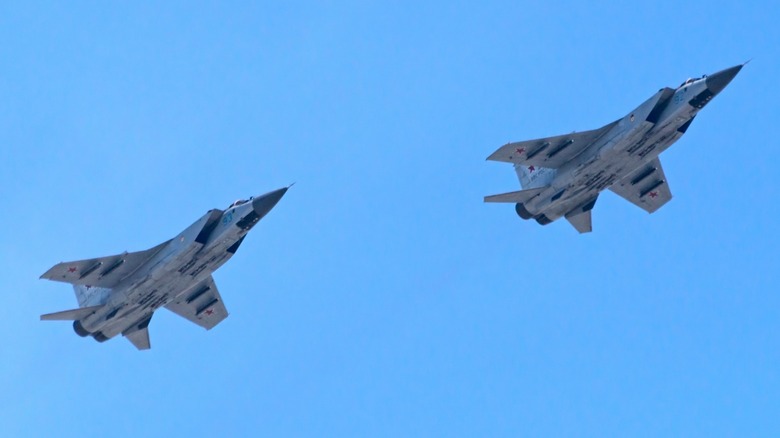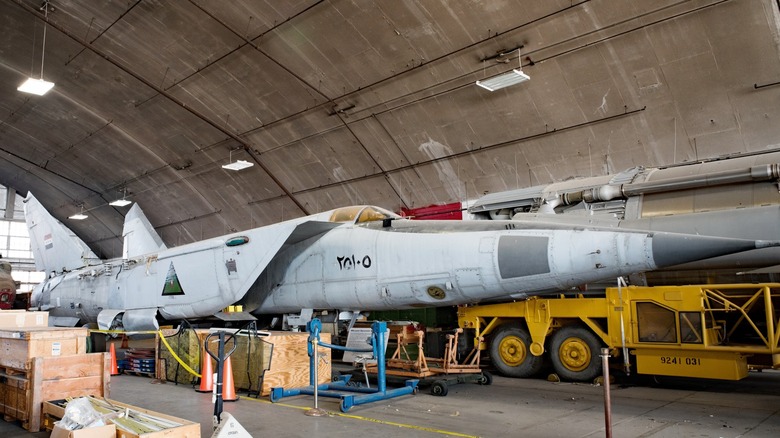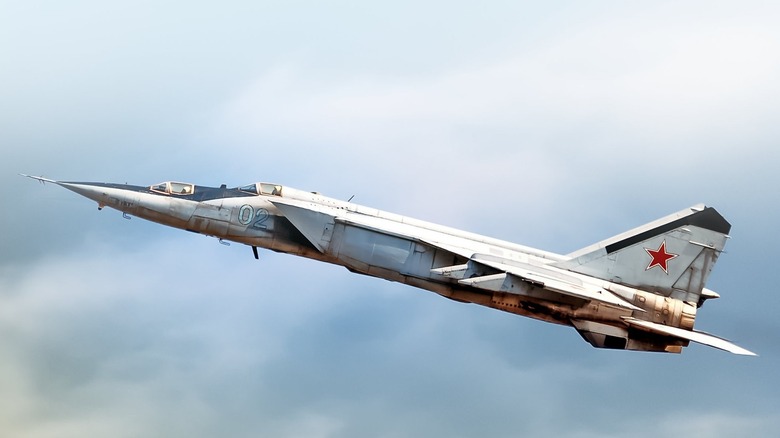Here's What Made The Mikoyan-Gurevich MiG-25 'Foxbat' Jet So Terrifying
When the U.S. government got its hands on spy shots of an early prototype of the Russian MiG-25 Foxbat, there was a bit of a panic. The U.S. assumed this massive fighter aircraft they were looking at was built to intercept bomb runs, and they were correct in that assumption. The MiG-25's purpose was to take aim at U.S. supersonic bombers and high-flying spy planes like the SR-71. In the midst of the Cold War era, this type of aircraft presented the U.S. with a pretty serious problem.
With a top speed of over Mach 3, this plane could — in theory — keep up with the almighty SR-71. Furthermore, the Foxbat's first public appearance saw it set 29 speed/altitude records, some even still stand to this day. With a climb to 98,425 feet in just four minutes and three seconds, and an operational ceiling at an eyewatering altitude of 123,520 feet, it seemed that all of the U.S.'s worst nightmares were coming true. Was that really the case, though?
Foxbat: all bark, no bite?
Though the top speed and fleet of records certainly are impressive, the Foxbat would go on to be something that the U.S. needed to worry about a lot less than one would have thought. In practice, the MiG-25 wasn't all that effective, and there's a few reasons why.
Russians had a handful of issues when it came to the execution of building the MiG-25. For one, the country was short on titanium technology, and when you want to build a light and fast plane, that presents a big issue. Instead, Russia largely built the aircraft with stainless steel. As a result, the Foxbat came in at a hefty 64,000 pounds. That's a full 10,000 pounds heavier than the era-equivalent F-4 Phantom II fighter jet on the U.S. side.
Another issue was the lack of hand-welding experience. The result was finish work that was so bad that rival countries looking at the plane thought they were looking at remarkably bad repair patches. Instead, though, they were looking at welds and body components that were straight from the factory.
Of course, vanity only gets you so far in warfare. It doesn't have to look good if it works good. So, did it? Well, no.
Weak armament and virtually useless radar
The only armament equipped to the interceptor version of the MiG-25 was four AA-6 missiles. These missiles were either guided by the aircraft's onboard radar or via the infrared signature of its target. At over 20 feet long, and sporting a warhead in excess of 200 pounds, it wasn't the most nimble and useful weapon out there. In fact, no Russian aircraft ever fired one of these missiles outside of training. One would down an F/A-18 from an Iraqi MiG-25 in the 1991 Persian Gulf War, with a second one causing damage to a USAF F-15 jet later that same year.
The Foxbat's radar system was also severely lacking. Its intent was to look up into the sky to dodge a Bomber's jamming signals from below. That's all well and good, but the radar was blind below 1,650 feet, and it didn't have any sort of look-down/shoot-down functionality. This made it effectively useless against U.S. bombers.
In addition, while the plane was capable of over Mach 3, its poor build quality meant those kinds of speeds would cause damage. Most were kept around Mach 2.8 at maximum, making it useless in chasing down an SR-71. Its unremarkable radar and missiles meant a head-on approach to the Blackbird wasn't effective, either.
When the U.S. got its hands on a MiG-25
In September of 1976, a struggling Russian fighter pilot named Viktor Belenko was facing the divorce of his wife and longing for life outside of the communist regime. During training, he defected from his training unit and made his way to Japan, landing at a civilian airport with only 30 seconds of fuel remaining.
The MiG-25 then made its way to U.S. hands, where the plane was meticulously disassembled and reverse-engineered. Belenko had even brought the plane's training manual, giving all the information one could ever ask for with the plane in hand. Ultimately, this was the final nail in the coffin to end the West's fear of the all-bark-no-bite MiG-25.
Still, it's worth considering that the MiG-25 did, in a way, execute its intention. It didn't chase down an SR-71 and end its run with a monumental explosion. However, the thought of that possibility did keep the SR-71 largely out of Russian airspace for quite some time.



